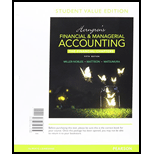
Horngren's Financial & Managerial Accounting, The Financial Chapters (Book & Access Card)
5th Edition
ISBN: 9780134078939
Author: Tracie L. Miller-Nobles, Brenda L. Mattison, Ella Mae Matsumura
Publisher: PEARSON
expand_more
expand_more
format_list_bulleted
Textbook Question
Chapter 10, Problem 7RQ
What method is used for investments in equity securities with 20% to 50% ownership? Briefly describe how dividends declared and received and share of net income are reported.
Expert Solution & Answer
Want to see the full answer?
Check out a sample textbook solution
Students have asked these similar questions
What percentage change in sales occurs if profit
What is income under full costing?
Hello tutor solve this question accounting
Chapter 10 Solutions
Horngren's Financial & Managerial Accounting, The Financial Chapters (Book & Access Card)
Ch. 10 - Prob. 1QCCh. 10 - Which of the following investments is most likely...Ch. 10 - If Intervale Railway invests 100,000 in 5% bonds...Ch. 10 - Prob. 4QCCh. 10 - Prob. 5QCCh. 10 - Prob. 6QCCh. 10 - Prob. 7QCCh. 10 - Harvard Co. purchased a trading investment on...Ch. 10 - Prob. 9QCCh. 10 - Prob. 10QC
Ch. 10 - What is a debt security?Ch. 10 - Prob. 2RQCh. 10 - Prob. 3RQCh. 10 - Briefly describe the five specific types of debt...Ch. 10 - How is the purchase of a held-to-maturity debt...Ch. 10 - Prob. 6RQCh. 10 - What method is used for investments in equity...Ch. 10 - What method is used for investments in equity...Ch. 10 - What adjustment must be made at the end of the...Ch. 10 - Where on the financial statements is an unrealized...Ch. 10 - Prob. 11RQCh. 10 - Prob. 12RQCh. 10 - Prob. 13RQCh. 10 - What does the rate of return on total assets...Ch. 10 - Identifying why companies invest and classifying...Ch. 10 - Prob. 10.2SECh. 10 - Prob. 10.3SECh. 10 - Accounting for equity method On January 1, 2016,...Ch. 10 - Accounting for trading investments On February 1,...Ch. 10 - Prob. 10.6SECh. 10 - Computing rate of return on total assets Kabra's...Ch. 10 - Prob. 10.8ECh. 10 - Prob. 10.9ECh. 10 - Accounting for bond investments Otter Creek Co....Ch. 10 - Accounting for stock investments Dollar Bill...Ch. 10 - Prob. 10.12ECh. 10 - Prob. 10.13ECh. 10 - Accounting for stock investments Suppose that on...Ch. 10 - Prob. 10.15ECh. 10 - Prob. 10.16ECh. 10 - A Accounting for bond investments Suppose Jenner...Ch. 10 - Prob. 10.18APCh. 10 - Accounting for stock investments The beginning...Ch. 10 - Accounting for bond investments Suppose Ritter...Ch. 10 - Classifying and accounting for stock investments...Ch. 10 - Accounting for stock investments The beginning...Ch. 10 - Prob. 10.23CPCh. 10 - Prob. 10.1CTEICh. 10 - Wild Adventure conducts tours of wildlife reserves...Ch. 10 - Prob. 10.1CTFSCCh. 10 - Prob. 10.1CTTPCh. 10 - In 150 words or fewer, explain the difference...
Knowledge Booster
Learn more about
Need a deep-dive on the concept behind this application? Look no further. Learn more about this topic, accounting and related others by exploring similar questions and additional content below.Similar questions
- Define in detail the following in relation to Organizational Ethics. The Ethical Culture of an organization. Define these Five Signs of Ethical Collapse a) Pressure to maintain the numbers b) Fear of reprisals c) Loyalty to the boss d) Innovations e) Goodness in some areas, atones for evil in othersarrow_forwardCalculate the stock in the beginningarrow_forwardI need help with this problem and accountingarrow_forward
- Provide correct solution and accountingarrow_forwardWhat is its DOL? Accounting questionarrow_forwardThe following data were selected from the records of Fluwars Company for the year ended December 31, current year: Balances at January 1, current year: Accounts receivable (various customers) $ 111,500 Allowance for doubtful accounts 11,200 The company sold merchandise for cash and on open account with credit terms 1/10, n/30, without a right of return. The following transactions occurred during the current year: Sold merchandise for cash, $252,000. Sold merchandise to Abbey Corp; invoice amount, $36,000. Sold merchandise to Brown Company; invoice amount, $47,600. Abbey paid the invoice in (b) within the discount period. Sold merchandise to Cavendish Inc.; invoice amount, $50,000. Collected $113,100 cash from customers for credit sales made during the year, all within the discount periods. Brown paid its account in full within the discount period. Sold merchandise to Decca Corporation; invoice amount, $42,400. Cavendish paid its account in full after the…arrow_forward
arrow_back_ios
SEE MORE QUESTIONS
arrow_forward_ios
Recommended textbooks for you
- Principles of Accounting Volume 1AccountingISBN:9781947172685Author:OpenStaxPublisher:OpenStax College
 College Accounting, Chapters 1-27AccountingISBN:9781337794756Author:HEINTZ, James A.Publisher:Cengage Learning,
College Accounting, Chapters 1-27AccountingISBN:9781337794756Author:HEINTZ, James A.Publisher:Cengage Learning,  Cornerstones of Financial AccountingAccountingISBN:9781337690881Author:Jay Rich, Jeff JonesPublisher:Cengage Learning
Cornerstones of Financial AccountingAccountingISBN:9781337690881Author:Jay Rich, Jeff JonesPublisher:Cengage Learning Financial And Managerial AccountingAccountingISBN:9781337902663Author:WARREN, Carl S.Publisher:Cengage Learning,
Financial And Managerial AccountingAccountingISBN:9781337902663Author:WARREN, Carl S.Publisher:Cengage Learning, Managerial AccountingAccountingISBN:9781337912020Author:Carl Warren, Ph.d. Cma William B. TaylerPublisher:South-Western College Pub
Managerial AccountingAccountingISBN:9781337912020Author:Carl Warren, Ph.d. Cma William B. TaylerPublisher:South-Western College Pub

Principles of Accounting Volume 1
Accounting
ISBN:9781947172685
Author:OpenStax
Publisher:OpenStax College

College Accounting, Chapters 1-27
Accounting
ISBN:9781337794756
Author:HEINTZ, James A.
Publisher:Cengage Learning,


Cornerstones of Financial Accounting
Accounting
ISBN:9781337690881
Author:Jay Rich, Jeff Jones
Publisher:Cengage Learning

Financial And Managerial Accounting
Accounting
ISBN:9781337902663
Author:WARREN, Carl S.
Publisher:Cengage Learning,

Managerial Accounting
Accounting
ISBN:9781337912020
Author:Carl Warren, Ph.d. Cma William B. Tayler
Publisher:South-Western College Pub
Financial ratio analysis; Author: The Finance Storyteller;https://www.youtube.com/watch?v=MTq7HuvoGck;License: Standard Youtube License